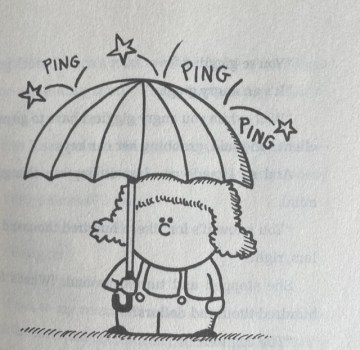 You’re in for an extra-special treat, Mixed-Up friends! Today, Stephan Pastis, the author/illustrator of the wildly popular and critically acclaimed New York Times bestselling Timmy Failure series—which was lauded by Kirkus as: “Wittier than the Wimpy Kid”—as well as the creator of the syndicated comic strip Pearls Before Swine, is here to chat about his latest illustrated MG novel, Looking Up. It’s out from Aladdin/S&S on October 10. (Spoiler alert: It’s AMAZING!!!) For a never-before-seen sneak peek at Stephan’s illustrations, read on…
You’re in for an extra-special treat, Mixed-Up friends! Today, Stephan Pastis, the author/illustrator of the wildly popular and critically acclaimed New York Times bestselling Timmy Failure series—which was lauded by Kirkus as: “Wittier than the Wimpy Kid”—as well as the creator of the syndicated comic strip Pearls Before Swine, is here to chat about his latest illustrated MG novel, Looking Up. It’s out from Aladdin/S&S on October 10. (Spoiler alert: It’s AMAZING!!!) For a never-before-seen sneak peek at Stephan’s illustrations, read on…
Summary of Looking Up

Living alone with her mother in a poorer part of town, Saint—a girl drawn to medieval knights, lost causes, and the protection of birthday piñatas—sees the neighborhood she has always known and loved disappearing around her: old homes being torn down and replaced by fancy condos and coffee shops. But when her favorite creaky old toy store is demolished, she knows she must act.
Enlisting the help of Daniel “Chance” McGibbons, a quiet, round-faced boy who lives across the street (and whose house also faces the wrecking ball), Saint hatches a plan to save what is left of her beloved hometown.
Interview with Stephan Pastis

MR: Welcome to the Mixed-Up Files, Stephan. So happy to have you here!
SP: Thank you for inviting me! And for all the kind words!
MR: First and foremost, I gobbled up your novel faster than a pint of Cherry Garcia ice cream—and that’s saying a lot. I absolutely LOVED it. Can you tell us what inspired you to write this story?
SP: Well thank you! I wanted to write a Don Quixote-type story, but instead of with a man fighting giants, mine would be about a little girl futilely fighting against the redevelopment of her neighborhood. Also, I had never done a middle-grade novel with a little girl as the main character, so I liked that challenge.
The Saint Comes Marching In

MR: Saint, the big-hearted, piñata-rescuing 11-year-old protagonist is, hands down, one of the most lovable and unconventional characters I’ve encountered in middle-grade fiction. How did you capture the essence of this wonderfully quirky character, and lay it out for readers on the page?
SP: Hahah thank you! I think I had just read Catcher in the Rye before writing it, and I loved Holden’s voice, how he talked directly to the reader, so there’s a little bit of that influence in there — maybe mixed in with the slightly delusional perspective of Don Quixote. I like characters who are overwhelmed by their surroundings and ill-equipped to deal with change.
Word Up!

MR: A discussion of Saint wouldn’t be complete without a mention of her impressive vocabulary. Saint uses such words as: “mendacity,” “depravity,” “sanctity,” “pilfered,” “germane,” “critical juncture,” “legal ramifications.” This is a bold move, considering it’s common wisdom for middle-grade writers to employ vocabulary that most of their audience is familiar with. Your thoughts?
SP: I think I did that with Timmy Failure too. Maybe it’s just the appeal of words like that coming out of a little kid’s mouth. The incongruity of their age and the maturity of the words makes me laugh. I think I pilfered “mendacity” from the Burl Ives character in a Cat on a Hot Tin Roof. He shouts it over and over.
The Truth About Turtles

MR: As a follow-up, can you tell me about Saint’s love for her pet turtle and “life partner,” Dr. Rutherford B. Hayes? There’s a ton of fascinating material to unpack here…
SP: Well, she doesn’t really have an active adult in her life. So I needed someone who could be the voice of reason, and give Saint perspective and wisdom. Of course, he’s also a blowhard, not to mention curmudgeonly, so he’s not the best at that. Plus, I liked the metaphor of the turtle—someone who retreats from the world into their own shell.
Promises, Promises

MR: Let’s move on to Saint’s relationship with her mother. You set up the story with Saint’s declaration that: “My mother breaks all her promises.” How does this affect Saint’s life overall, and what does this say about promises—and promise breaking?
SP: Yeah, that’s a complicated relationship. I think Saint needs a lot more than she’s getting from her mom, especially at the point of her life she’s in. And since she’s not getting what she needs, she’s lashing out. I don’t know if Saint’s mom breaks any more promises than the average mom; I think Saint’s just at a breaking point and can’t take any more disappointment.
Only the Lonely
MR: Loneliness is another prominent theme in your book. Both Saint and her across-the-street neighbor, Daniel, suffer acutely from loneliness. Without sharing any spoilers, can you tell us how Saint’s loneliness manifests itself in her life? What about Daniel’s?
SP: Well, without an active parent in her day-to-day life, she copes by making friends with turtles and piñatas (which she rescues from kids’ birthday parties), and by living mostly in her imagination. I think her imagination is her coping mechanism. Daniel’s as well.
Invasion of the Latte Sippers

MR: Looking Up also explores the issue of neighborhood gentrification; specifically, when one group of residents feels intruded upon by a new, unfamiliar population. What were you aiming to say about gentrification, and displacement in general?
SP: Well, you see a lot of it in the Marigny and Bywater neighborhoods of New Orleans, where I spend a lot of time. And when it happens, the neighborhoods slowly lose what’s unique about them—namely, long-time residents who really are what give the city its personality.
The Juggler


MR: In addition to being an author of illustrated middle-grade novels—including the über-popular Timmy Failure series—you are the creator of the syndicated comic strip Pearls Before Swine, which appears in over 800 newspapers. You’ve also cowritten the Disney+ movie Timmy Failure: Mistakes Were Made. How do you juggle everything without dropping the ball? I can barely walk and chew gum!
SP: Thank you! Well, I work pretty much seven days a week, but because I love it, it never feels like work (or very rarely). That’s the real key—loving what you do. It’s cliché, but true. I had a truly stressful job as a lawyer for 10 years, so this never feels like work compared to that.
Timmy Failure: The Movie

MR: Speaking of the Timmy Failure: Mistakes Were Made movie, how much time did you spend on the set? And, maybe more important: Did you get to meet Wallace Shawn? 🙂 Also, is there a Timmy Failure: Mistakes Were Made sequel in the works? Rumor has it that you’ve been working on the script.
SP: I was on set every day for the entire four months of pre-production and filming, half in Vancouver and half in Portland.
And yes, I did meet Wallace Shawn! I talked to Wally whenever I could. I wrote the script for the sequel, but I’m not sure if it will get made. Would be great if it did, though.
Stephan’s Writing Routine

MR: What does your writing/illustrating routine look like? Do you have any particular rituals?
SP: Crazy ritual. I turn off all the lights (I just have the light of the computer screen), light incense, and play really loud music.
MR: What are you working on now, Stephan? Enquiring Mixed-Up Files readers want to know.
SP: A book of all my travel adventures. I travel a lot and have been to a lot of unique places. [For more on how travel opens our eyes as writers and readers, check out this article from the MUF archives.]
Lightning Round!

MR: And finally, no MUF interview is complete without a lightning round, so…
Preferred writing snack? Those little pretzels stuffed with peanut butter.

Coffee or tea? Coffee for sure. I wouldn’t trust anyone who said tea.
Zombie apocalypse: Yea or nay? Yea.
Superpower? To shut out all distractions when I write.
Favorite comic strip (besides Pearls Before Swine)? The Far Side.

Favorite place on earth? New Orleans, Louisiana.
If you were stranded on a desert island with only three things, what would they be? A Confederacy of Dunces by John Kennedy Toole. The Joshua Tree by U2. Tacos.



MR: Thank you for chatting with us, Stephan. It was an absolute pleasure, and I’m sure MUF readers will agree!
SP: Thank you!
All About Stephan

Stephan Pastis is the creator of the syndicated comic strip Pearls Before Swine, which appears in over 800 newspapers. He is also the creator of the Timmy Failure Book series and the cowriter of the Disney+ movie Timmy Failure: Mistakes Were Made. He lives in Northern California with his wife and two kids. Learn more about Stephan on his website and follow him on Twitter, Instagram, and Facebook.









 With a triple-decker ice cream cone on the cover,
With a triple-decker ice cream cone on the cover,  Another book with ice cream on the cover is
Another book with ice cream on the cover is 

 Want a bit of humor with your ice cream? Tom Watson has the perfect recipe –
Want a bit of humor with your ice cream? Tom Watson has the perfect recipe –  If you prefer a more serious novel, try
If you prefer a more serious novel, try 